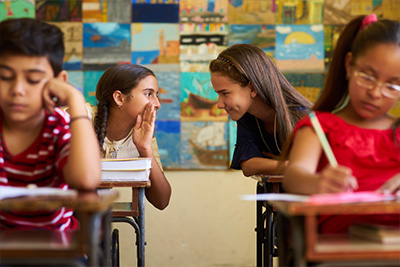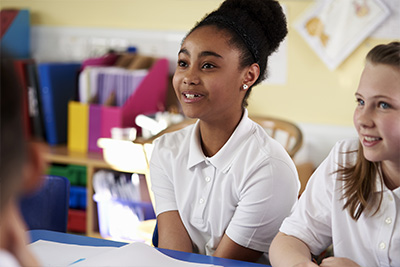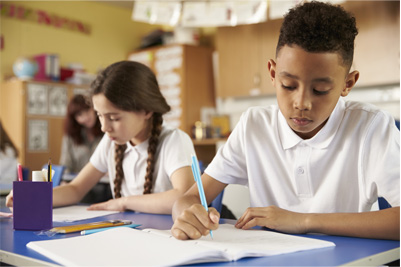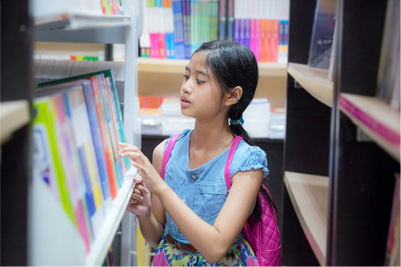How can teachers increase the chances that their students will behave appropriately?
Page 7: Use Surface Management Strategies
 Of course, no classroom structure—regardless of how thoughtfully executed—can prevent every instance of every disruptive behavior. Other tools teachers can use to limit or discourage challenging behavior are called surface management strategies. These simple, nonintrusive methods of responding to minor undesirable behaviors (or surface behaviors) allow teachers to proactively address student behavior. Surface management strategies can be used to prevent, interrupt, or stop these behaviors as soon as they begin and before they escalate without interrupting instruction.
Of course, no classroom structure—regardless of how thoughtfully executed—can prevent every instance of every disruptive behavior. Other tools teachers can use to limit or discourage challenging behavior are called surface management strategies. These simple, nonintrusive methods of responding to minor undesirable behaviors (or surface behaviors) allow teachers to proactively address student behavior. Surface management strategies can be used to prevent, interrupt, or stop these behaviors as soon as they begin and before they escalate without interrupting instruction.
Surface management strategies can be used frequently throughout the day. They are quick, easy, and avoid embarrassing or even publicly identifying the student or students to whom they are directed. The teacher might find that he can effectively deal with the behavior by using one of the surface management strategies outlined below. To improve the likelihood of success, it is helpful if the teacher knows the unique needs and personality of each student.
| Strategy | Definition |
| Redirecting | Asking the student to do a task, such as reading or answering a question, to refocus the student’s attention. |
| Planned ignoring | Intentionally dismissing or not acknowledging a student’s behavior as long as the teacher is confident that the behavior (e.g., tapping a pencil) will run its course and will not disrupt or spread to others. |
| Signaling | Using a variety of non-verbal signals (e.g., establishing eye contact, clearing one’s throat) to communicate disapproval of the student’s behavior. |
| Proximity control |
Reducing distance between the student and the teacher that helps the student to control impulses. For more information on this practice, review the following IRIS Fundamental Skill Sheet: |
| Interest boosting | Displaying genuine interest in a child’s work or interests (e.g., sports, pop culture, movies) to help build a relationship and rapport, which in turn might increase the student’s motivation to continue to work on the assignment. This is useful when a student’s interest in a task is waning or when she is becoming restless. |
| Use of humor | Using a humorous comment or joke to ease a tense or anxious situation. However, the teacher should never make a student the brunt of the joke or humorous comment. |
| Hurdle help | Assisting a frustrated, overwhelmed, or unmotivated student (e.g., by working the first two or three division problems together) to help her to get started and to become invested in the task at hand. |
| Removing the object | Directing a student to put away the distracting object (e.g., toy car, cell phone) so that he is better able to concentrate on his assignments, observe classroom rules, and continue to learn. |
| Antiseptic bouncing | Temporarily removing a student from the setting (e.g., letting the student get a drink of water or deliver a message to another teacher) to permit her the time to regain composure and control her behavior. This strategy is not designed to punish the student. |
Adapted from Long & Newman (1980) and Levin & Nolan (2010).
With so many surface management strategies, it may seem overwhelming to decide which is best to use in a given situation. Successfully applying surface management strategies takes time and practice. Remember, different strategies work with different students. It’s important for teachers to create strong relationships with students to know which strategies will work best based on the student’s personality and individual needs.
Activity
Wondering how many surface management strategies a teacher can complete in one day or class period? Hint: all of them! Try to spot the surface management strategies Ms. Rollison uses with her students.

While going over announcements at the beginning of the day, Ms. Rollison notices that Lissa is whispering to her friend. As Lissa continues to whisper, Ms. Rollison pauses for a moment, makes eye contact with Lissa, and continues to go over the announcements. Realizing that Ms. Rollison paused and made eye contact, Lissa stops talking to her friend and faces forward in her seat.





Knowing that today’s lesson would be challenging, Ms. Rollison added a few silly cat memes to her presentation slides the night before. As Ms. Rollison expected, a few students became frustrated when they had trouble with the assignment. Asking the class to pause for a moment, Ms. Rollison shows her students the cat memes and everyone begins to laugh.





Guillermo stares dreamily out the window while the class reviews yesterday’s homework assignment. Noticing that he is distracted, Ms. Rollison calls on him to answer question #2.





SaNiya has a habit of quietly humming to herself when she writes in her notebook. Although Ms. Rollison notices her humming, other students continue to focus on their work. SaNiya continues to hum for another moment, shifts around in her seat, and then falls silent.





Nate thinks he can use his phone under his desk without Ms. Rollison noticing. Nate is wrong. Ms. Rollison instructs him to put the phone away and continue working on his assignment. Nate knows he’s been caught and puts his phone in his backpack. He continues to work on his assignment.





Ms. Rollison can tell Taylor is struggling with the first few questions on the independent practice. Ms. Rollison walks over to Taylor’s table and helps her answer the first two questions, reminding her of the class notes and modeling correct ways to answer the questions. Afterward, Taylor feels confident enough to continue working on the assignment independently.





Weston puts his head down while the class reads a short story aloud together. When Ms. Rollison calls on a classmate to read the next paragraph, she walks near Weston’s desk and pauses. Noticing that his teacher is near, Weston picks up his head and begins to follow along while his classmate reads aloud.





Ms. Rollison knows that Bryson loves to read books about Harry Potter. While in class, Ms. Rollison notices that Bryson is getting antsy and keeps looking at the clock. Ms. Rollison walks over to his desk, bends down, and asks, “How do you think Harry Potter would finish this assignment?” Bryson smiles and focuses again on his work.





Valencia is clearly upset when she walks into Ms. Rollison’s classroom. As students are completing bell work, Ms. Rollison writes a message on a sticky note that says, “Ms. Donelson has a library book I need. Can you get it for me quickly?” and puts it on Valencia’s desk. Valencia returns a few minutes later with the book and sits down, clearly in a better mood.



